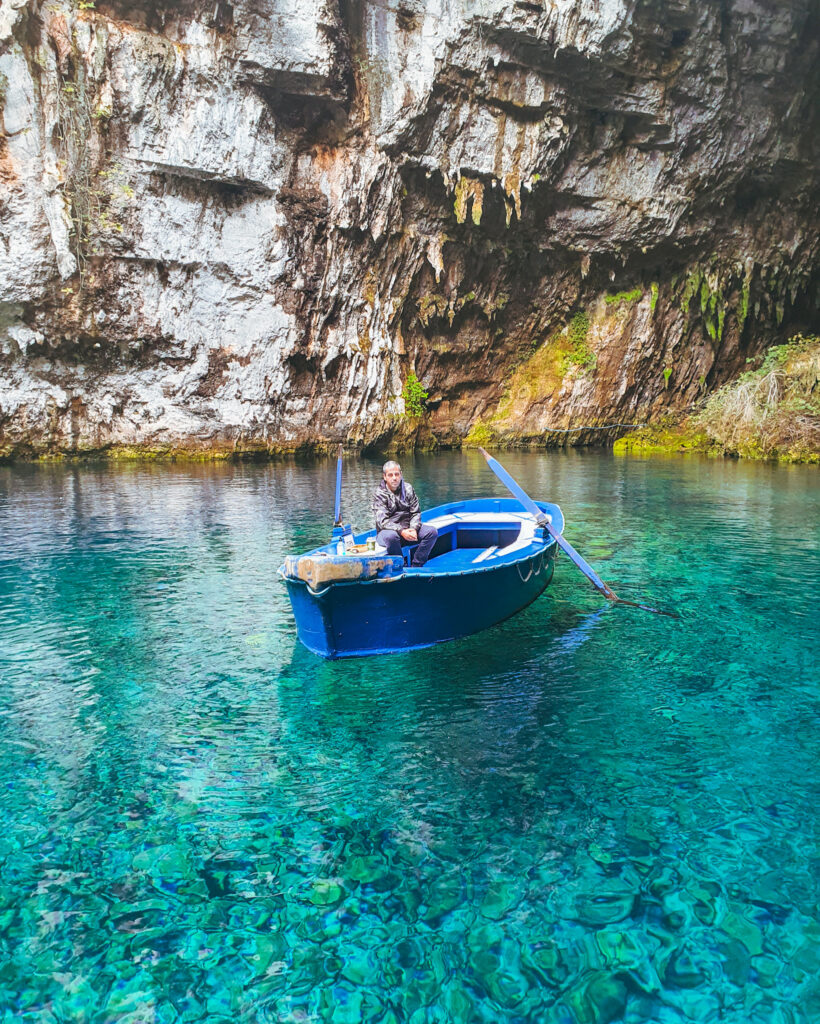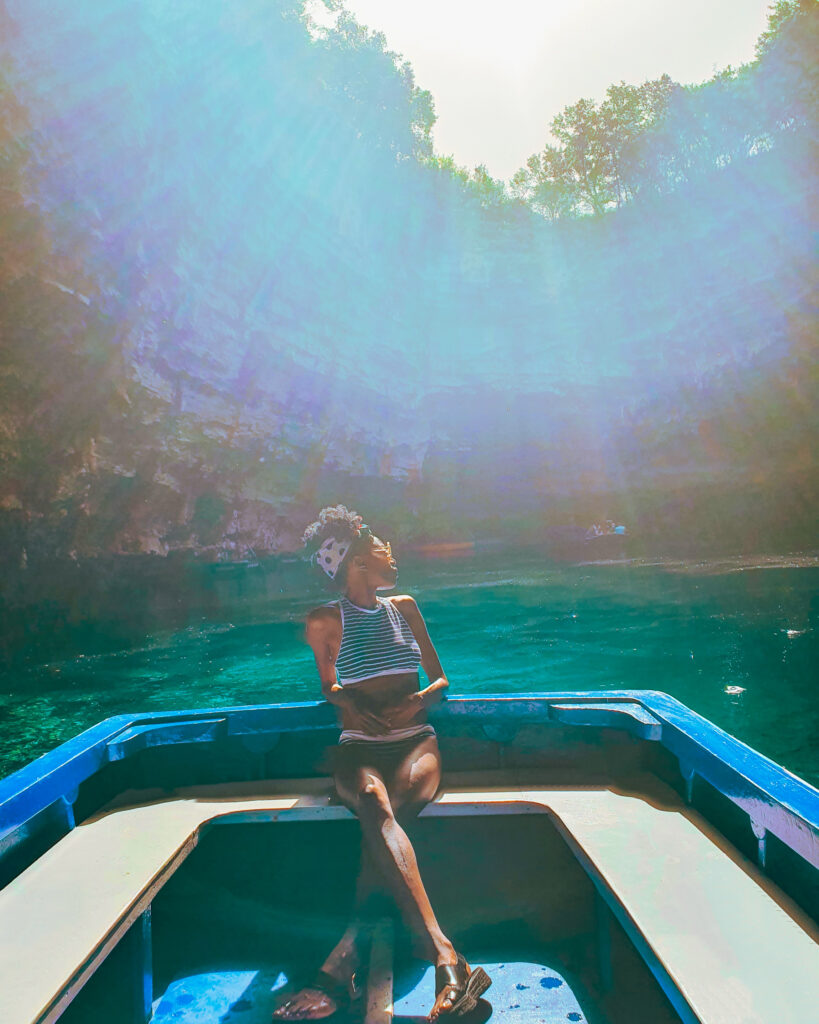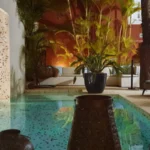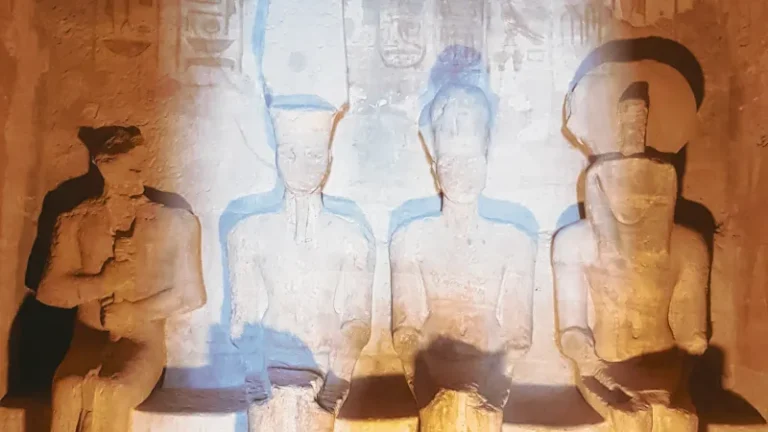
The light at the end of the tunnel
The tunnel leading to the lake is a dark, long, rectangular-shaped carpeted tube, but the aquamarine blues at the end glisten from a distance. Captivating me, this hurries me down the incline, legs outrunning torso as I eagerly make my descent. “Hold onto the rails – the floor is wet!” exclaims a male staff member. Whatever, at this point, I am way too excited to take any notice of the saturated floor, already saying “wow” before I even reach. “You wait until you get there”, he utters.
The history of Melissani Cave
Melissani Cave is guarded by thick forest and created through the dissolution of rocks. As a result of the density of woodland, it was only rediscovered in 1951.
This cave, a shrine in Greek mythology, was dedicated to one of the oldest Greek gods, Pan (God of the wild) and the Nymphs. Centred in nature, worship of Pan was often in caves or grottos. Nymphs, usually depicted as beautiful maidens and companions of the gods, are generally regarded as embodiments of nature and typically tied to a specific place.
According to local legend, a nymph called Melissanthe tragically committed suicide in the lake when god Pan rejected her love for him.

What to expect
At the end of the tunnel, I am greeted by guides awaiting tourists in rowing boats. As one of Kefalonia’s top tourist attractions, there are usually many, but 2020 has dwindled attendance to few.
The lake’s waters are a hypnotic mixture of vibrant blues. Even so, I can’t help but repeatedly nod my head up to the cavity in the roof, edged with forest green, and back down to the water, to discern any deception caused by the daylight above.

What next?
After helping me onto the boat, my guide begins to row us onto the lake. I note the varying tones of blue, as well as a small school of the fish shimmying their way across the glass-clear seawater. To demonstrate just how translucent the water is, my guide gestures to the stones at the very bottom of the lake, visible even at its highest depth of 30 metres.
Continuing, we make our way across the B-shaped cave from the large open area and approach an islet, which separates the two chambers. It is worth noting – it is here that several artefacts were discovered from the 3rd and 4th century when excavated in 1962, indicative of a place of ritual. Items found included a figurine of god Pan and a clay plate showing dancing nymphs. These finds are now on display at the Argostoli Archaeological Museum.

Moving on, the passage leading to the next room is so narrow that the guide stops rowing and uses the rope fastened against the wall as a handle to shuffle us through.
At this point, the atmosphere changes significantly. In contrast to the previous room, the second chamber is small, closed and dark. As well as that, the curious display of bizarrely shaped stalactites above and the alluring azure waters below makes it simultaneously both beautiful and eerie. I wonder if this contrast is perhaps much like god Pan himself. My guide then points out the stalactites resemblance to dolphins, which play a significant role in Greek mythology.

Be the light you seek
Thankfully we don’t spend too long in the second room, and upon making our way back into the main lagoon, the cave opens back up. Then, like a light bulb shining through a lampshade, the sunlight – now directly over the cavity in the roof – streaks straight through. Additionally, the aquamarine waters create a magical illusion as the sunlight bounces off the water, illuminating the chamber with supernatural blues. Also, intriguingly, the echoing droplets of water ricocheting off the lake’s surface make it even more captivating.
It is customary to tip the guide, and there is no possibility of me forgetting this. Grabbing some coins from his tip box, he theatrically throws them back in, exclaiming “thank you!”. I find this hilarious. He deserves the tip for his comedy element alone.
Tips:
When visiting Melissani Cave, no time is the same. The effect you get is weather dependent. But, make sure you go at midday when the sun is directly above the opening.
Apart from visiting Melissani Cave, find out what else to do in Kefalonia.












